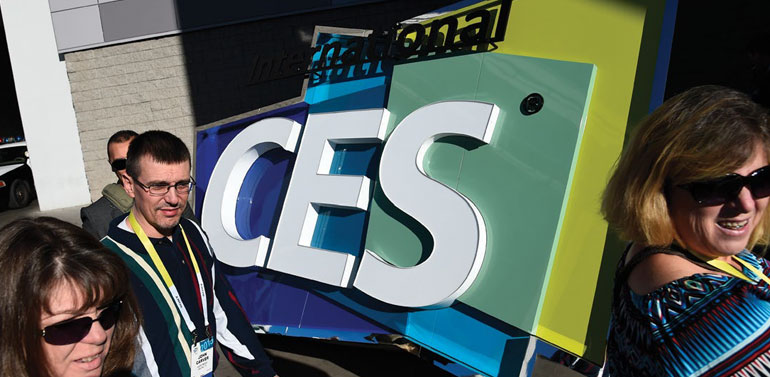Technology
Five Major Tech Trends From CES

Every year thousands of exhibitors, retailers and tech enthusiasts descend on Las Vegas for the annual Consumer Electronics Show (CES). This annual digital pilgrimage is a chance to enjoy an advance preview of cutting-edge products before they hit the market, as well as an opportunity to identify the next big consumer trends before they happen.
Internet connectivity is going to be everywhere
The Internet of Things – a world of massive machine-to-machine communication – is set to transform our world as we welcome connected objects such as smart watches, connected TVs and web-enabled monitoring systems into our lives. Cisco’s Visual Networking Index (VNI) Global Mobile Data Traffic Forecast reported last year that by the end of 2014, the number of mobile-connected devices would exceed the number of people on earth, and that “there will be over 10 billion mobile-connected devices by 2018, including machine-to-machine (M2M) modules—exceeding the world’s population at that time (7.6 billion)”.
Wearable technology options are growing, but it is still a niche market
Wearables are one of the areas where this 24/7 mobile-enabled connectivity is likely to have the biggest impact.
Although wearable technologies like Google Glass, Fitbit and Pebble are still relatively new concepts, they are already quite well known among digital enthusiasts and early adopters. As a result, they enjoy a media profile which somewhat overlooks the fact that they are still quite specialist products.
Globally, Cisco estimates there were c.22 million connected wearable devices in use during 2013.
Jump forward to 2018, however, and this market is expected to have grown eight-fold to 177 million. At an anticipated compound annual growth rate of 52%, this is a sector which many industry experts think looks set to explode.
All eyes are now on the forthcoming Apple Watch to really see if the mainstream potential of the market will be realised.
Digital health monitoring is going to become more sophisticated
Wrist-based wearables have tended to dominate this budding industry, so it was only a matter of time before this type of technology moved to other parts of the body.
Sensoria’s smartsock – which was exhibited at CES and begins retailing next winter – was a high-profile example of a potential new market in the wearables arena.
Using sensors embedded in the soles of their specialist socks, data is then sent to a removable anklet and synched to your smartphone. Through an accompanying app, runners can then use this data to monitor how their feet hit the ground. Sensoria claims that by recording your technique in this way the risk to injury can be reduced; and running techniques (as well as running times) can be improved.
And if that all sounds a bit too active, then don’t worry; technologies designed to help improve our sleep are also increasingly in abundance.
It’s an area where there is a huge amount of interest, a fact best exemplified last year when the 22-year-old British entrepreneur James Proud attracted $1.3 million for his sleep product, Sense. Using the popular crowdfunding website Kickstarter, he raised this sum in just one week. His rather more modest ambition had been to raise $100,000 over four weeks.
Capturing data via a clip attached to your pillow, as well as the inevitable mobile app, Sense joins the smartsock in being part of a small and embryonic group of wearables that no longer need to be worn at the end of your arm.
Connected cars are coming sooner than you might realise
Outside of the home, Google’s self-driving car has attracted considerable publicity in recent years.
But, it was Mercedes who grabbed the attention of CES show-goers when its self-driving F015 drove itself onto the conference stage.
Meanwhile, both VW and BMW showed that gesture-based controls aren’t just going to be confined to your games console. Their future in-vehicle infotainment systems will soon be motion controlled, making redundant even relatively recent innovations such as touchscreen dashboards. These in-car systems will also be compatible with either your Android or Apple smartphone, allowing you to run the same apps through the car’s infotainment system as you do on your handheld device.

-

 Banking & Finance1 week ago
Banking & Finance1 week agoOman Oil Marketing Company Concludes Its Annual Health, Safety, Environment, and Quality Week, Reaffirming People and Safety as a Top Priority
-

 Economy2 months ago
Economy2 months agoMaal Card: What Oman’s New National Payment Card Means for Everyday Users
-

 Leaders Speak2 months ago
Leaders Speak2 months agoDhofar International Development and Investment Company: Driving Sustainable Growth and Strategic Synergies in Oman’s Investment Landscape
-

 Events2 months ago
Events2 months agoOER Corporate Excellence Awards 2025 Honours Entities and Innovations in Oman
-

 News2 months ago
News2 months agoSheikh Suhail Bahwan, Chairman of Suhail Bahwan Group, Passes Away
-

 News1 month ago
News1 month agoOIG Appoints New CEO to Lead Its Next Chapter of Excellence
-

 Economy2 months ago
Economy2 months agoOman Unveils Official Omani Rial Symbol in Landmark Move to Boost Global Currency Presence
-

 News1 month ago
News1 month agoReport: How India & The Middle East Are Exploiting Immense Economic Synergies



























You must be logged in to post a comment Login